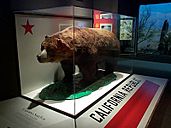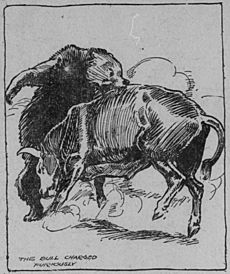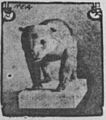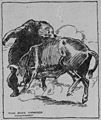California grizzly bear facts for kids
Quick facts for kids California grizzly bear |
|
|---|---|
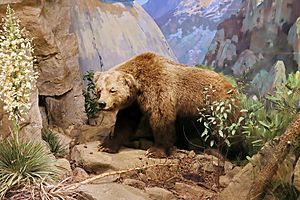 |
|
| Specimen at the Santa Barbara Museum of Natural History | |
| Conservation status | |
| Scientific classification |
|
| Kingdom: | Animalia |
| Phylum: | Chordata |
| Class: | Mammalia |
| Order: | Carnivora |
| Family: | Ursidae |
| Genus: | Ursus |
| Species: | |
| Subspecies: |
†U. a. californicus
|
| Trinomial name | |
| Ursus arctos californicus Merriam 1896
|
|
| Synonyms | |
|
|
The California grizzly bear (Ursus arctos californicus) was a type of brown bear that is now extinct. It was also known as the "grizzly bear." The name "grizzly" might have come from the golden and grey tips of its hair. It could also have meant "fear-inspiring."
In 1815, a naturalist named George Ord officially named it Ursus horribilis, meaning "terrifying bear." This name was chosen because of its fierce nature. California grizzly bears were very similar in size and color to the Kodiak bear found in Alaska. People in California admired these bears for their beauty, size, and strength. The grizzly bear became a symbol for the California Republic, a short-lived attempt by settlers to break away from Mexico in 1846. This rebel flag later became the basis for the state flag of California. Because of this, California is often called the "Bear State."
Contents
What is a California Grizzly Bear?
For a long time, scientists found it hard to classify North American brown bears. One researcher in 1918 even thought there were 86 different types!
However, modern DNA testing showed that all North American brown bears, including the California grizzly, belong to the same species as other brown bears around the world. This made their classification much simpler.
Where Did They Live?
Before Spanish settlers arrived in the late 1700s, about 10,000 grizzly bears lived in what is now California. They were found almost everywhere in the state. Only the far southeastern and northeastern parts did not have them.
These bears ate many different things. Their diet included plants like grasses, seeds, berries, and acorns. They also ate animals such as deer, salmon, and steelhead. Sometimes, they would eat dead animals, including whales found on the beach.
How Did Humans and Grizzlies Interact?
Early Encounters
The first written records of Europeans seeing California grizzly bears come from the 1769 Portolá expedition. This was the first European land trip into California. Some places in California, like Los Osos, are named after the Spanish word for bear, oso.
As more settlers came to California, they started large cattle farms. These farm animals were easy prey for the grizzlies. Because the bears ate their livestock, ranchers saw them as enemies. Vaqueros, who were cowboys, hunted the grizzlies. They often captured them to use in public fights against other animals.
The California grizzly was a very large bear. An early missionary, Father Pedro Font, described them as "horrible, fierce, large, and fat." In the 1800s, newspapers reported bears weighing over 1,000 pounds. One huge grizzly killed in 1866 was said to weigh as much as 2,200 pounds. This would make it one of the biggest bears ever recorded.
Why Did They Disappear?
In the late 1700s, Spanish ranchers used poisoned bait to kill bears. They would hang a ball of fat or animal insides with poison in a tree. This was high enough for bears to reach but safe from dogs and children. Mexican settlers also captured bears for fights and sold their skins.
Bear-baiting events, where bears fought other animals like bulls, were very popular in the 1800s. People would bet on which animal would win. There's a common story that the stock market terms "bear" and "bull" came from these fights. The story says a famous newspaperman, Horace Greeley, saw a fight and named them based on how the animals fought. However, this story is not true; the terms were used long before he visited California.
European settlers also paid rewards, called bounties, for killing bears that attacked their livestock. Hunters like Absolom Beasley claimed to have killed many bears. Seth Kinman, a famous mountain man, said he shot over 800 grizzlies in 20 years.
The last California grizzly bear was reportedly shot in Tulare County, California, in 1922. However, no body or proof was ever found. In 1924, a grizzly was seen in Sequoia National Park for the last time. Less than 75 years after gold was discovered in 1848, almost all grizzly bears in California were gone.
Can They Come Back?
California still has places that could support about 500 grizzly bears. In 2014, a request to bring grizzlies back to California was turned down. In 2015, another group asked the state to reintroduce them.
Scientists have even thought about trying to bring the California grizzly bear back from extinction. This could involve using special breeding, cloning, or genetic engineering.
A Symbol of California
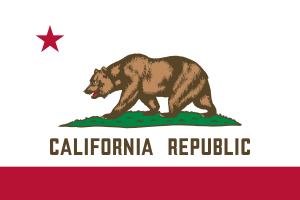
The California grizzly bear is one of the state's most important symbols. You can see it on both the state flag and the state seal. The Bear Flag first flew in 1846 during the short-lived California Republic. A new version became the official state flag in 1911.
The bear symbol became a permanent part of the state seal in 1849. In 1953, the California grizzly bear was named the official state animal. The bear is also the mascot for sports teams at the University of California, Berkeley (the California Golden Bears) and the University of California, Los Angeles (the UCLA Bruins). The California Maritime Academy even has a training ship named Golden Bear.
Images for kids
-
Specimen at the Santa Barbara Museum of Natural History
-
Monarch, a specimen preserved at the California Academy of Sciences
-
An illustration of a bear bullfight by HM Stoops. Published in The San Francisco Call on January 15, 1911.
-
The official Flag of California.
See also
 In Spanish: Oso grizzly de California para niños
In Spanish: Oso grizzly de California para niños



